Issam Ahmed and Lucie Aubourg
Thu, July 14, 2022

The first stunning images from the James Webb Space Telescope were revealed this week, but its journey of cosmic discovery has only just begun.
Here is a look at two early projects that will take advantage of the orbiting observatory's powerful instruments.
- The first stars and galaxies -

One of the great promises of the telescope is its ability to study the earliest phase of cosmic history, shortly after the Big Bang 13.8 billion years ago.
The more distant objects are from us, the longer it takes for their light to reach us, and so to gaze back into the distant universe is to look back in the deep past.
- ADVERTISEMENT -
"We're going to look back into that earliest time to see the first galaxies that formed in the history of the universe," explained Space Telescope Science Institute astronomer Dan Coe, who specializes in the early universe.
Astronomers have so far gone back 97 percent of the way back to the Big Bang, but "we just see these tiny red specks when we look at these galaxies that are so far away."
"With Webb, we'll finally be able to see inside these galaxies and see what they're made of."
While today's galaxies are shaped like spirals or ellipticals, the earliest building blocks were "clumpy and irregular," and Webb should reveal older redder stars in them, more like our Sun, that were invisible to the Hubble Space Telescope.
Coe has two Webb projects coming up -- observing one of the most distant galaxies known, MACS0647-JD, which he found in 2013, and Earendel, the most distant star ever detected, which was found in March of this year.
While the public has been enticed by Webb's stunning pictures, which are shot in infrared because light from the far cosmos has stretched into these wavelengths as the universe expanded, scientists are equally keen on spectroscopy.
Analyzing the light spectrum of an object reveals its properties, including temperature, mass, and chemical composition -- effectively, forensic science for astronomy.
Science doesn't yet know what the earliest stars, which probably started forming 100 million years after the Big Bang, will look like.
"We might see things that are very different," said Coe -- so-called "Population III" stars that are theorized to have been much more massive than our own Sun, and "pristine," meaning they were made up solely of hydrogen and helium.
These eventually exploded in supernovae, contributing to the cosmic chemical enrichment that created the stars and planets we see today.
Some are doubtful these pristine Population III stars will ever be found -- but that won't stop the astronomical community from trying.
- Anyone out there? -

Astronomers won time on Webb based on a competitive selection process, open to all regardless of how advanced they are in their careers.
Olivia Lim, a doctoral student at the University of Montreal, is only 25 years old. "I was not even born when people started talking about this telescope," she told AFP.
Her goal: to observe the roughly Earth-sized rocky planets revolving around a star named Trappist-1. They are so close to each other that from the surface of one, you could see the others appearing clearly in the sky.
"The Trappist-1 system is unique," explains Lim. "Almost all of the conditions there are favorable for the search for life outside our solar system."
In addition, three of Trappist-1's seven planets are in the Goldilocks "habitable zone," neither too close nor too far from their star, permitting the right temperatures for liquid water to exist on their surface.
The system is "only" 39 light year away -- and we can see the planets transit in front of their star.
This makes it possible to observe the drop in luminosity that crossing the star produces, and use spectroscopy to infer planetary properties.
It's not yet known if these planets have an atmosphere, but that's what Lim is looking to find out. If so, the light passing through these atmospheres will be "filtered" through the molecules it contains, leaving signatures for Webb.
The jackpot for her would be to detect the presence of water vapor, carbon dioxide and ozone.
Trappist-1 is such a prime target that several other science teams have also been granted time to observe them.
Finding traces of life there, if they exist, will still take time, according to Lim. But "everything we're doing this year are really important steps to get to that ultimate goal."
ia/dw
Why the new James Webb Space Telescope images are so important for science
The first images from the Webb Telescope have wowed the world with their beauty. But what do they mean for the future of astronomy?
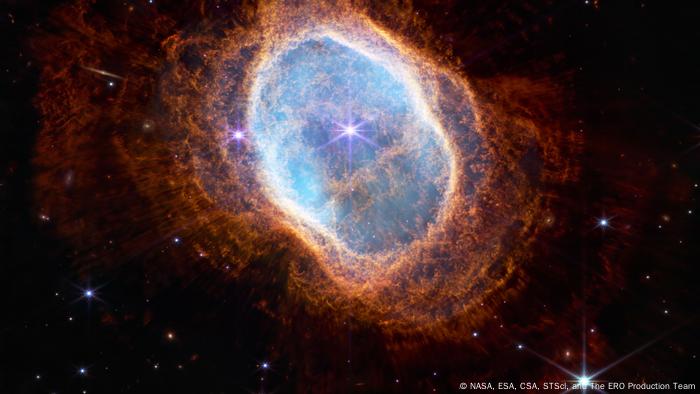
The James Webb Space Telescope images are much more than just pretty pictures.
Planet Earth had its head in the sky when the James Webb Space Telescope's first images of the cosmos were revealed.
Five stunning images showcased the telescope's capabilities, capturing views of stars being born and a group of galaxies locked in a cosmic dance. The pictures are the deepest and sharpest color images of the universe so far.
While celebrating the beauty of the images, scientists have been keen to point out the scientific significance of the international project, which is a collaboration between NASA, the European Space Agency (ESA) and the Canadian Space Agency (CSA).
"These images show us that Webb works incredibly well. Webb will help us to study our universe in much more detail," said Kai Noeske, an astronomer and communications officer at the European Space Operations Centre (ESOC).
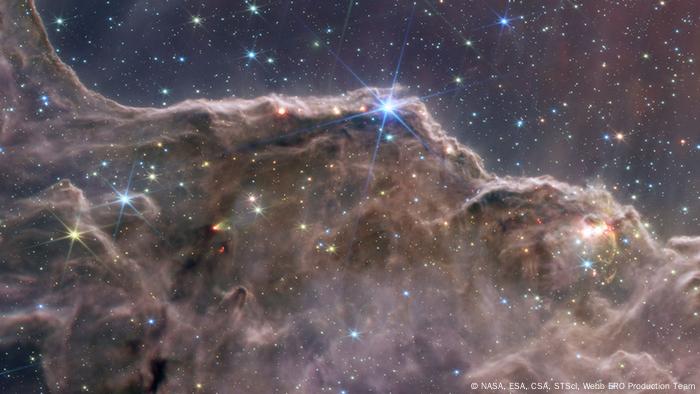
INSIDE THE COSMOS: JAMES WEBB SPACE TELESCOPE'S FIRST IMAGES
The invisible made visible
What might look like a glittering moutainous landscape is actually the edge of a young star-forming region called NGC 3324 in the Carina Nebula. The Webb Telescope image reveals for the first time areas of star birth that were previously invisible.
12345
Looking back in time
Webb's first image was a deep field image of a tiny spec of the vast universe, showing distant galaxy clusters. Some of these galaxies are more than 13 billion years old and were created when the universe was in its infancy.
"It is light from the early universe, in its first 500 million years, which is reaching us today," Noeske told DW.
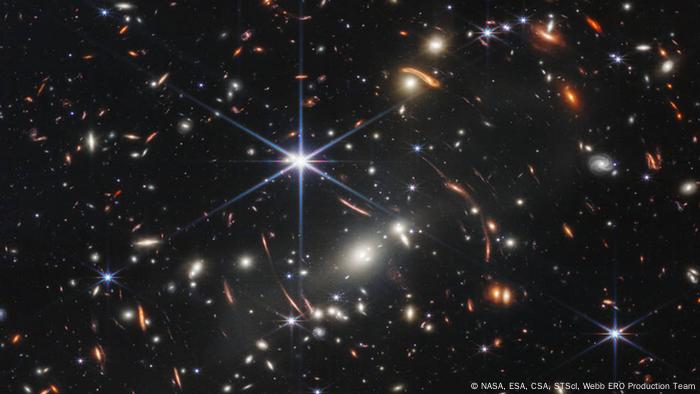
Light from these galaxies is up to 13 billion years old, only reaching Webb in the last weeks
The curious effect of looking back in time is caused by the speed of light and how long light takes to reach us. Light travels at 300,000 kilometers every second (about 670 million miles per hour). This is extremely fast. But space is really big, so it can still take a long time for light to travel.
For example, the sun is about 150 million kilometers (93 million miles) from Earth, and it takes around eight minutes for light to reach us from our sun.
The objects in Webb's images are many billions of light-years away. One light-year is the distance traveled by light in one year, which is about 9.5 trillion kilometers.
This means the light has traveled through space and time to reach us over billions of years. We would have to wait another 13 billion years to see these galaxies as they are today.
The scale of these distances is difficult to imagine, but it certainly makes a walk to the store feel rather short by comparison.
Making the invisible visible
In the kaleidoscopic images of the Carina Nebula and Stephan's Quintet, Webb shows us emerging stellar nurseries where stars are being born and developing. Scientists have never been able to observe galaxies interacting in this much detail.
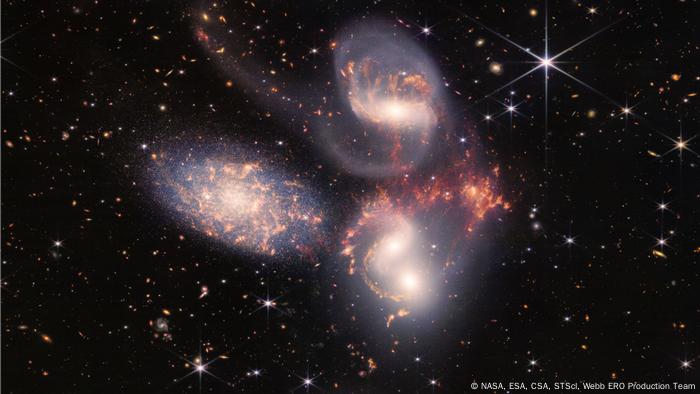
The five galaxies of Stephan’s Quintet in a cosmic dance
It's thanks to Webb's infrared cameras that we're able to see the stars in all their glory.
"Infrared gives us a lot more information on the young universe than was possible before. The light from these galaxies was stretched as it traveled to us. Webb lets us see that," says Noeske.
The colors in the Cosmic Cliffs were artificially added to the original image by Webb’s science team. However, that's not to say the colors are not there. In fact, the light emitted from stars contains information far richer than we can see with the human eye.
Researchers use data about light emitted from stars to understand how galaxies form, grow, and merge with each other, and in some cases why they stop forming stars altogether.
For example, blue galaxies contain stars but very little dust. The red objects are enshrouded in thick layers of dust, while green galaxies are populated with hydrocarbons and other chemical compounds.
"Webb will address some of the great, open questions of modern astrophysics: What determines the number of stars that form in a certain region? Why do stars form with a certain mass?" NASA said in a press release on Tuesday.
Richer information about the universe
It will take weeks and months to analyze the first images and demonstrate more of what Webb is capable of doing in the future.
Each photo we see is a composite of many hours of imaging. Study teams will "slice and dice" the information into many images for detailed study, much like clinicians do with magnetic resonance imaging (MRI).
"It was a big step forward from what Hubble showed us. The sharpness and level of detail made it clear how much potential Webb has for scientific research. Webb not only looks further back in time, but also in higher detail," Noeske told DW.
Webb will help scientists to answer questions about how planets, stars, galaxies, and ultimately the universe itself, are formed.
Finding Earth 2.0?
While less beautiful than the Cosmic Cliffs, Webb's spectrographic analysis of the exoplanet WASP-96 b's atmosphere is an example of perhaps more exciting information to come in the future.
WASP-96 b is a type of gas giant around 1,150 light-years away that bears little similarity to the planets in our solar system. Webb's team has analyzed the planet's transmission spectrum, measuring starlight filtered through the planet's atmosphere like a barcode.
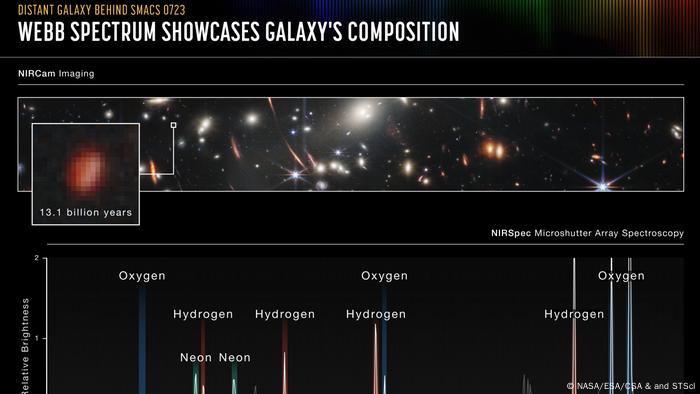
Analysis of light emitted through the atmosphere of WASP-96 b shows it contains water
"This is an amazing trick that astronomers use. The planet passes in front of its star — a bit of light passes through the planet's atmosphere, and that light shining contains the chemical signature of the atmosphere imprinted into it like a barcode," said Noeske.
The analysis showed the planet has an atmosphere that contains water, along with clouds and haze. But WASP-96b won't be supporting life as we know it any time soon, as the planet is made of gas and orbits its star extremely closely, making it an extremely hot and hostile environment.
The analysis of WASP-96 b provides a hint of what Webb has in store for exoplanet research. Exactly what will happen is yet to be determined.
The telescope is open to proposals from worldwide scientific communities about which exoplanets to study in the future.
Edited by: Louisa Wright
The first images from the Webb Telescope have wowed the world with their beauty. But what do they mean for the future of astronomy?

The James Webb Space Telescope images are much more than just pretty pictures.
Planet Earth had its head in the sky when the James Webb Space Telescope's first images of the cosmos were revealed.
Five stunning images showcased the telescope's capabilities, capturing views of stars being born and a group of galaxies locked in a cosmic dance. The pictures are the deepest and sharpest color images of the universe so far.
While celebrating the beauty of the images, scientists have been keen to point out the scientific significance of the international project, which is a collaboration between NASA, the European Space Agency (ESA) and the Canadian Space Agency (CSA).
"These images show us that Webb works incredibly well. Webb will help us to study our universe in much more detail," said Kai Noeske, an astronomer and communications officer at the European Space Operations Centre (ESOC).

INSIDE THE COSMOS: JAMES WEBB SPACE TELESCOPE'S FIRST IMAGES
The invisible made visible
What might look like a glittering moutainous landscape is actually the edge of a young star-forming region called NGC 3324 in the Carina Nebula. The Webb Telescope image reveals for the first time areas of star birth that were previously invisible.
12345
Looking back in time
Webb's first image was a deep field image of a tiny spec of the vast universe, showing distant galaxy clusters. Some of these galaxies are more than 13 billion years old and were created when the universe was in its infancy.
"It is light from the early universe, in its first 500 million years, which is reaching us today," Noeske told DW.

Light from these galaxies is up to 13 billion years old, only reaching Webb in the last weeks
The curious effect of looking back in time is caused by the speed of light and how long light takes to reach us. Light travels at 300,000 kilometers every second (about 670 million miles per hour). This is extremely fast. But space is really big, so it can still take a long time for light to travel.
For example, the sun is about 150 million kilometers (93 million miles) from Earth, and it takes around eight minutes for light to reach us from our sun.
The objects in Webb's images are many billions of light-years away. One light-year is the distance traveled by light in one year, which is about 9.5 trillion kilometers.
This means the light has traveled through space and time to reach us over billions of years. We would have to wait another 13 billion years to see these galaxies as they are today.
The scale of these distances is difficult to imagine, but it certainly makes a walk to the store feel rather short by comparison.
Making the invisible visible
In the kaleidoscopic images of the Carina Nebula and Stephan's Quintet, Webb shows us emerging stellar nurseries where stars are being born and developing. Scientists have never been able to observe galaxies interacting in this much detail.

The five galaxies of Stephan’s Quintet in a cosmic dance
It's thanks to Webb's infrared cameras that we're able to see the stars in all their glory.
"Infrared gives us a lot more information on the young universe than was possible before. The light from these galaxies was stretched as it traveled to us. Webb lets us see that," says Noeske.
The colors in the Cosmic Cliffs were artificially added to the original image by Webb’s science team. However, that's not to say the colors are not there. In fact, the light emitted from stars contains information far richer than we can see with the human eye.
Researchers use data about light emitted from stars to understand how galaxies form, grow, and merge with each other, and in some cases why they stop forming stars altogether.
For example, blue galaxies contain stars but very little dust. The red objects are enshrouded in thick layers of dust, while green galaxies are populated with hydrocarbons and other chemical compounds.
"Webb will address some of the great, open questions of modern astrophysics: What determines the number of stars that form in a certain region? Why do stars form with a certain mass?" NASA said in a press release on Tuesday.
Richer information about the universe
It will take weeks and months to analyze the first images and demonstrate more of what Webb is capable of doing in the future.
Each photo we see is a composite of many hours of imaging. Study teams will "slice and dice" the information into many images for detailed study, much like clinicians do with magnetic resonance imaging (MRI).
"It was a big step forward from what Hubble showed us. The sharpness and level of detail made it clear how much potential Webb has for scientific research. Webb not only looks further back in time, but also in higher detail," Noeske told DW.
Webb will help scientists to answer questions about how planets, stars, galaxies, and ultimately the universe itself, are formed.
Finding Earth 2.0?
While less beautiful than the Cosmic Cliffs, Webb's spectrographic analysis of the exoplanet WASP-96 b's atmosphere is an example of perhaps more exciting information to come in the future.
WASP-96 b is a type of gas giant around 1,150 light-years away that bears little similarity to the planets in our solar system. Webb's team has analyzed the planet's transmission spectrum, measuring starlight filtered through the planet's atmosphere like a barcode.

Analysis of light emitted through the atmosphere of WASP-96 b shows it contains water
"This is an amazing trick that astronomers use. The planet passes in front of its star — a bit of light passes through the planet's atmosphere, and that light shining contains the chemical signature of the atmosphere imprinted into it like a barcode," said Noeske.
The analysis showed the planet has an atmosphere that contains water, along with clouds and haze. But WASP-96b won't be supporting life as we know it any time soon, as the planet is made of gas and orbits its star extremely closely, making it an extremely hot and hostile environment.
The analysis of WASP-96 b provides a hint of what Webb has in store for exoplanet research. Exactly what will happen is yet to be determined.
The telescope is open to proposals from worldwide scientific communities about which exoplanets to study in the future.
Edited by: Louisa Wright
No comments:
Post a Comment